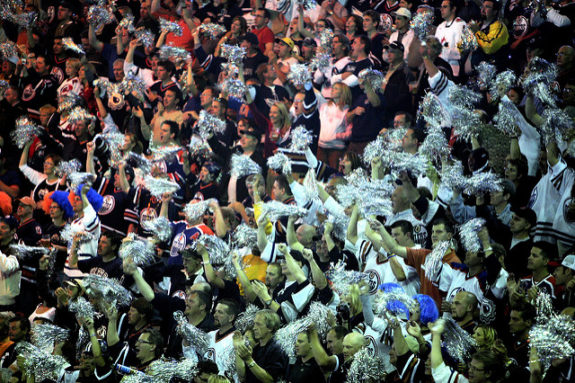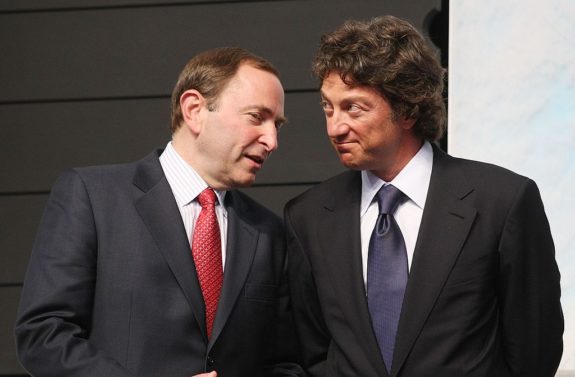Not too long ago, things weren’t the greatest in Oil Country. There was, of course, “The Decade of Darkness” when the Edmonton Oilers went 10 straight years without an NHL playoff berth between 2007 and 2016. And now, even though Edmonton boasts an all-time great duo in Connor McDavid and Leon Draisaitl, they have just two playoff series win in the last 16 years.
But for all the heartbreak and disappointment they’ve endured, there’s not a single Edmonton fan that would rather go without Oilers hockey in their city. This takes us back 25 years, to May 31, 1996: The day Edmonton saved the Oilers.
Edmonton’s Downward Trend
Throughout the 1980s, the Oilers were the hottest ticket in town and Edmonton was the center of the hockey universe. With a lineup that included seven future Hall-of-Famers, the Oilers won five Stanley Cups between 1984 and 1990, playing before sellout crowds of more than 17,000 at Northlands Coliseum.

But by the early ‘90s, the team had fallen on harder times. One after another, Edmonton’s stars were traded out of town, and the Oilers had dropped down the standings, going from championship contenders to not even contending for a playoff spot. Attendance likewise declined, a slow drip that began in 1990 and had reached alarming levels by 1995, when it was not uncommon to see less than 10,000 fans in attendance at the re-named Edmonton Coliseum.
The loonie had also plummeted, bottoming out at barely over 70 cents against the American Dollar, making matters increasingly difficult for Canadian franchises. The Quebec Nordiques were now the Colorado Avalanche, having relocated in the 1995 off-season; the Jets would soon be headed south, becoming the Phoenix Coyotes in 1996; and the threat of the Oilers following their ex-WHA brethren to the U.S. was very real.
Pocklington Threatens Move
In late 1995, Oilers owner Peter Pocklington said he would have to move the team if it did not sell 13,000 season tickets and 90 percent of corporate seats by May 31, 1996. Doing so would qualify the Oilers to receive $2.5 million CDN through the NHL’s Canadian Currency Assistance Plan, which had been created to assist small-market Canadian teams struggling with the exchange rate. (from ‘The man who saved the Oilers’, The Edmonton Journal, 10/02/05′).
At that point, the Oilers season ticket base sat at just 6,200. It would need to be more than doubled in about six months. Doug Piper, who had just come on board as the Oilers’ new executive vice president of business operations, recognized that meant distancing the team from Pocklington, who had become increasingly reviled by fans. (From ‘It’s How Edmonton Operates’, The Hartford Courant, 04/28/96).
“There was just a lack of community support that had to be turned around. The people love this team, but some healing had to take place.”
Doug Piper
Cal Nichols and fellow Edmonton businesspeople formed the Friends of the Oilers, a volunteer group to drive ticket sales. They appealed to local small business operators and put the heat on larger corporations.
Bit by bit, tickets sold. 13,000 was drawing closer, but so too was May 31. According to various reports in The Edmonton Journal, the number was in the low 9,000s on April 6, at 10,600 on May 1, and around 11,000 on May 23. Like a one-goal game late in the third period, this was going to come down to the finish.
Ticket Drive Reaches Target
On May 30, one day before the deadline, sales surpassed 13,000 when the Real Canadian Superstore purchased 1,000 tickets. By noon on May 31, season tickets stood at 13,482. Edmonton had done it. (From ‘Ticket Sales Over The Top’, The Edmonton Journal, 06/01/96).
Fans celebrated during an afternoon rally at Edmonton City Hall, where the Oilers marked the occasion by debuting their new uniforms, modeled by captain Kelly Buchberger and All-Star goalie Curtis Joseph. Mayor Bill Smith thanked ticket-buyers, and even Pocklington was warmly received when he spoke. “We were hurtling toward a brick wall, but the community took the wall down …” the owner said.
You may also like:
- Edmonton Oilers’ 5 Biggest December Trades in Franchise History
- Fresh-Start Trade Scenario Taking Shape Between Oilers and Maple Leafs
- Calvin Pickard Continues to Prove His Value to the Edmonton Oilers
- Top 10 Edmonton Oilers Players of All Time
- NHL Rumors: Suzuki & Team Canada, Maple Leafs & Marchment, Mangiapane Trade
The honeymoon wouldn’t last for long. A year later, the Alberta Treasury Branch called in its loans on Pocklington, forcing him to put the Oilers on the market. The team was mere hours away from being purchased by Texas millionaire Les Alexander who would move the Oilers to Houston, where he owned the NBA’s Rockets. But just before the deadline, on March 13, 1998, the Edmonton Investors Group (EIG), headed by Nichols and made up of 37 other entrepreneurs, matched Alexander’s offer, keeping the Oilers in Edmonton. After a decade of ownership, the EIG sold the Oilers to Edmonton billionaire Daryl Katz, owner of the Rexall Pharmacy empire, for $200 million US in 2008.

Edmonton’s most recent – and hopefully last – brush with losing the Oilers came in 2012 when Katz threatened to move the team to Seattle. Katz, who had been at an impasse in negotiations with the City of Edmonton to get a new arena built, later recanted, taking out full-page newspaper ads to apologize to fans. Katz and the city eventually reached an agreement on a new arena in downtown Edmonton; Rogers Place opened in 2016.
For the first time in decades, the Oilers have enjoyed an extended period of off-ice stability. For 2020, Forbes valued the franchise at $550 million US, with an operating income of $16.9. That ranked the Oilers 14th of the NHL’s 31 franchises and behind only the Toronto Maple Leafs and Montreal Canadiens among the seven based in Canada. Edmonton fans no longer have sleepless nights over losing their team. The only sleep they lose these days is over their team losing games.
